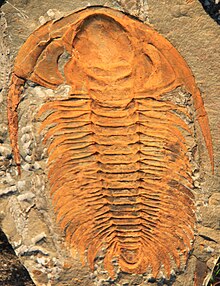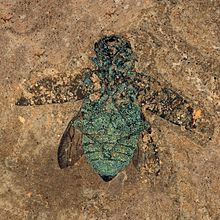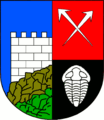fossil

A fossil ( Latin fossilis 'excavated' ) is any evidence of past life in the history of the earth that is older than 10,000 years and can therefore be assigned to a geological age before the beginning of the Holocene . Such geological documents can be both physical remains of living beings ( body fossils ) as well as evidence of their activity ( trace fossils ). For example, fossilized footsteps and excrement ( coprolite ) are also counted among the fossils. The formation of fossils is called fossilization . Research into fossils is primarily carried out through paleontology .
The term "petrification" or outdated "petrefact" ( Latin petra [from ancient Greek πέτρα] stone, factum "made") is not synonymous, because not every fossil is mineralized and is therefore present as a petrification.
According to scientifically sound estimates, around one billion animal and plant species have emerged since the beginning of the Phanerozoic 541 million years ago and most of them became extinct again . Some estimates even run to 1.6 billion. Far less than one percent of this biodiversity has been preserved in fossil form, not only because of the special circumstances required for fossilization, but also because many fossils have been destroyed again over the course of millions of years as a result of weathering , erosion or rock metamorphosis. Around 250,000 fossil species had been scientifically described by 1999 .
Historical

Finds of marine organisms contained in rocks on the mainland already attracted attention in ancient times and in the Middle Ages from China to Europe, and they were correctly recognized by several scholars (including Xenophanes , Eratosthenes , Leonardo da Vinci ) as the remains of organisms or as the legacy of a former one Interpreted sea cover. In contrast, they were viewed by the ancient Greek philosopher Aristotle and the scholastics who built on his teachings as whims of nature ( Lusus naturae ).
The term fossil was first used in 1546 by Georgius Agricola in his work De natura fossilium . If, as Agricola did, all curiosities found "during the excavation" were initially named indiscriminately as fossils , including minerals , artifacts , strangely shaped roots or concretions , over time the meaning narrowed to objects that testified to the existence of primeval life . The French Jean-Baptiste Lamarck contributed significantly to this with the chapter Sur les fossiles in his comprehensive work on the systematics of invertebrates, which appeared in 1801. Common names for fossils were petrefact and petrification , and in fact, in many cases, fossils are formed by replacing organic with mineral matter. Accordingly, the pre-form of modern paleontology was called petrefactology well into the 19th century . As early as 1667, the Dane Nicolaus Steno was the first modern scholar to prove that fossils are not the whims of nature, but the remains of living beings from earlier times.
Noun fossil vs. Adjective fossil
In addition to the term fossil as a noun , the word is also used as an adjective to characterize objects or formations that are geologically relatively old. In this sense, the adjective fossil is still not used exclusively for the remains of living beings, for example in the word combination fossil fuels ( coal , oil , natural gas ) or fossil water (very old deep groundwater). The opposite of the adjective fossil is recent . It denotes all formations that are geologically relatively young. Geological evidence, the age of which lies in the border area between fossil and recent, can be described as subfossil or subrecent . This applies to formations from the Quaternary period to around 8000 BC. Chr. (See also → Prehistory ). In palaeobotany , however, subfossil often also refers to incomplete fossilization , i.e. a certain state of conservation. In this sense, even flora from the Paleogene (older than 25 million years) can still be considered subfossil.
In biology and paleontology , the adjective fossil is also used to refer to extinct species . "Fossil species" are those species that became extinct before the turn of the Pleistocene to the Holocene , that is more than around 12,000 years ago. The fossil species can be contrasted with the more recent species that only died out in the Holocene or that still exist today. The so-called living fossils also mean (recent) species, not individual specimens. The totality of all fossil species currently known science and their occurrence is the fossil record or even fossil record (English fossil record called).
In geomorphology , surface forms are referred to as fossils that still exist today, but whose formation process came to a standstill in the geological past (so-called inactive structures). This also applies to formations that are significantly younger than 10,000 years, for example inactive Holocene cliffs in landfall areas on the German Baltic Sea coast.
Classification

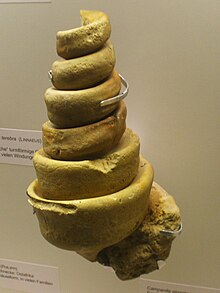


Body fossils
Body fossils are fossils that can be traced back directly to whole bodies or individual body parts of dead living beings. They are further differentiated according to their size
- Macrofossils , which are visible to the naked eye and sometimes reach the size of a house (as a rule, macrofossils are meant when "fossils" are generally used),
- Mesofossils that are only visible with the help of a magnifying glass (the term is rarely used),
- Microfossils that are onlyvisiblewith the help of a light microscope (the mesofossils are often included here) and
- Nannofossils that are onlyvisiblewith the help of an electron microscope .
In the case of body fossils, the word “body” does not necessarily stand for the original body tissue, but the tradition often takes place by replacing parts of the tissue or the entire tissue with minerals or sediment. The preservation of unchanged body substance as well as the partial or complete replacement of body substance by minerals is also called original preservation . In animals, this usually does not affect the soft parts, but only the hard mineral parts (hard part skeletons). Since many invertebrates have exoskeletons, their fossils often don't look very different from living animals. Examples are mollusks with housings made of calcite or Cenozoic mollusks with aragonite housings. In vertebrates with their internal skeletons, the fossil differs more from the living animal. Exceptions are the paleozoic bony fish with their scales that were already heavily mineralized during their lifetime. Soft tissues generally have a low conservation potential and the older a sediment layer is, the less likely it is that soft tissues have been preserved in it. Therefore, for example, the large-scale original preservation of dinosaur skin in Cretaceous sediments is extremely rare. Some organic substances also have a relatively high conservation potential, for example the chitin of arthropods or the sporopollenin of pollen and plant spores . Plants are often passed down as charred , which means that their tissue is dehydrated and chemically converted in the absence of air, so that carbon accumulates in them. A relatively rare form of original preservation is inclusion in amber . In this form, in addition to parts of plants, mainly small, terrestrial invertebrates, mostly insects, have been handed down.
While meso-, micro- and nannofossils that can be recognized as such usually appear in original preservation, a distinction is made between various other preservation forms for macrofossils:
- Stone core ( internal mold ): This special case of a body fossil is typical for invertebrates with an exoskeleton ("housing") made of minerals that are unstable over geological times. After the animal dies and is embedded in the sediment, the organic matter inside the housing breaks down and a cavity is formed. The surrounding sediment subsequently penetrates into these cavities and into any cavities that were already present in the housing before death and fills them completely or partially. If the exoskeleton is removed over the course of the next million years, the filling of the case is retained and is handed down as a stone core. Stone cores are typical of pre-Cenozoic mollusks with aragonite shells, especially ammonites, snails and certain mussels. There are two special forms of stone core tradition:
- When embossing Steinkern the outer sculpture of the housing that generates a negative impression of the surrounding sediment is imprinted on the stone core according Weglösung of the housing. The embossed stone core is a typical form of tradition in ammonites and certain pre-Cenozoic mussels.
- The milestone core is a traditional form of the shoot axes ("stems") of weakly woody plants: the tissue inside the shoot axes, the so-called pith , disintegrates significantly faster than the outer "bark" after the plant dies. This creates the so-called medullary cavity. If the medullary cavity is filled with sediment, the cavity filling remains after the disintegration of the “bark” and can be handed down as a marrow stone core. Landmark cores are typical forms of conservation of the trunks of giant horsetail ( calamites ).
- Footprint (engl. Impression , external mold ): Footprints are the negative forms of body fossils in original condition and rock cores. Sometimes, however, the original skeletal substance of the embedded organism is completely removed from the rock in the course of the diagenesis without prior stone core formation, so that only an impression remains. Vertebrates are particularly predestined for this because, due to their internal skeletons, they can only be preserved as stone cores in exceptional cases. Such print preservation comes u. a. at Mesosaurus -Skeletten in the Whitehill formation in South Africa and in land vertebrate skeletons in the Middle red sandstone and in Kännelkohle the upper carboniferous front of North America. In such cases, the study of the anatomy of animals preserved in this way does not take place on the impression, but this is poured with latex or silicone (formerly gutta-percha ) and only this cast is then examined and described.
Trace fossils
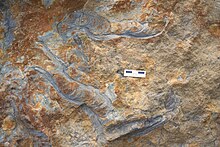
As trace fossils or traces of life all the testimonies of living things that are not due to their dead bodies especially those legacies that were generated by the activity of living beings apply. These include, for example, fossil-preserved footsteps and tracks, burial tunnels in the sediment (see also → Bioturbation ), drill marks in fossil wood or in limestone, as well as traces of eating and grazing (e.g. bite marks on fossil bones). A special form of the traces of life are fossil eggshells in fossil clutches. This also includes digestive residues, for example the excrement pills of small fish and invertebrates, which are often invisible to the naked eye in the rock. Larger "excrement stones", so-called coprolites , as well as fossil vaults and spits (the latter often only preserved in Quaternary cave sediments) represent a link to the body fossils, because they often contain remains of the original material of the prey of coprolite and vault producers.
meaning
Paleobiology
Tribal history documents
The enormous number and variety of species included in the fossil record is one of the most important arguments in favor of the theory of evolution . It shows that in the course of the history of life innumerable forms appeared and disappeared again on earth. This former diversity cannot be derived from the existence of today's forms alone. In the fossil record, there are not only relatively close relatives of organisms living in the present, but also groups of animals and plants that were once blooming but extinct without descendants (see also evolutionary history ). Furthermore, in combination with sedimentological investigations, especially by determining the deposit environment of fossil-bearing layers, evolutionary developments beyond ecological boundaries, such as the shore leave of different groups of organisms (higher plants, arthropods, vertebrates), can be traced.
Witnesses of past habitats
Fossils serve as references to former geographical and ecological conditions. For example, some fossil species and Ichnospecies are considered typical of a very specific deposit environment . They are therefore called pointer fossils or facies indicators . In addition, certain associations of trace fossils with body fossils (e.g. predation traces ), as well as body fossils with body fossils, can reveal something about the trophic relationships (“ food chains ”) in primeval ecosystems. A relatively spectacular example of this are broken tyrannosaurus teeth stuck in the bones of herbivorous dinosaurs. Less known but much more surprising were the finds of plant remains in the stomach area of the Permian reptile Protorosaurus , which had previously been classified as a pure carnivore based on its teeth.
Furthermore, geochemical analyzes of fossils in their original state, especially measurements of the ratios of the stable isotopes of oxygen and carbon, can provide information about the local and, with correspondingly comprehensive sampling, also about the global environmental conditions in past geological ages, including about the paleotemperature. A morphometric method to Paläotemperaturbestimmung based on a presumed dependence of the maximum height change warm vertebrates from the average ambient temperature, that is, differences in size of closely related alternately warm species (eg. B. boider snakes ) that occur in different ages layers of a particular region, relative temperature differences reflect between the corresponding living worlds. Using the microstructures of various marine organisms, it was determined that the length of the day on earth has increased continuously over the past millions of centuries as a result of changes in the earth-moon system (see also → Geo-archive ).
According to the current state of research, the oldest fossil evidence of life on earth includes stromatolites from the Isua greenstone belt in Greenland, which are believed to be up to 3.7 billion years old. They show that the shelf seas were of great importance as a habitat even on early Earth. Microscopic mineral structures (so-called hematite filaments), which are interpreted as fossils of primitive unicellulars, could even be up to 4.28 billion years old. They come from ribbon iron ores of the Nuvvuagittuq greenstone belt , which are said to have emerged from sedimented precipitates from submarine hydrothermal sources . These finds support the hypothesis that life originated at such sources in deeper regions of the ocean.
stratigraphy
Geological timescale
The law of Steno states, among other things, that in an undisturbed stack of layers of sedimentary rocks, the oldest layers are at the bottom and the youngest layers are at the top. In this way, the age of a shift or of several consecutive shifts (a so-called shift interval s) can be specified relative to another shift or another interval. One also speaks of the relative age .
The Englishman William Smith discovered towards the end of the 18th century that layers of a certain relative age contain very specific fossils that are not found in layers of any other relative age. He took advantage of these observations by creating a table that could be used to stratigraphically categorize the entire geological tradition of Great Britain . The categorization took place in the form of standardized intervals, which were defined by the occurrence of certain fossils and named after the rock typical for this interval (e.g. chalk , coal measures, etc.). Real strata intervals could be assigned to one of the standard intervals based on their fossil content (correlation), even if they did not consist of the typical rock. Smith was the inventor of biostratigraphy and the geological timescale , although his "timescale" was only applicable regionally and the standard scale that is still used today around the world was developed only in the further course of the 19th century.
While the geological time scale was initially still used to determine the relative age of a stratum within the entire geologically traditional stack of strata, the methods of radiometric dating developed in the 20th century finally opened up the possibility of comparing the relative time intervals with absolute ages, i.e. H. with numerical values. Since then, it has been known how old the earth actually is and that, for example, the Cretaceous began around 150 million years ago and ended around 65 million years ago. However, as a rule, it is not the fossil-bearing sedimentary rocks that are absolutely dated, but igneous , often pyroclastic rocks that are located above and below the fossil-bearing layer intervals, whereby the numerical minimum and maximum age of the fossil-bearing interval can be determined.
Index fossils

Fossils, on the basis of which the relative age of a sedimentary sequence, in the best case of a single layer, can be determined, are referred to as index fossils .
A good index fossil should meet the following requirements:
- brief geological occurrence (low stratigraphic range)
- frequent occurrence in the corresponding stratigraphic interval
- wide geographical distribution
- occurrence largely independent of the rock formation ( facies ) closely linked to the deposit environment ("facies-breaking")
- easy to recognize
These requirements are intended to ensure that as many fossil-containing layers in the world as possible also contain index fossils and that layers that contain the same index fossil have been formed in the same, relatively narrowly defined period of earth's history, regardless of where in the world they are today or where they were at the time of deposit.
Important examples are:
- different species of trilobites from the Lower Cambrian (541 mya ) to the Upper Silurian (419.2 mya), extinct from the Permian
- different types of ammonites from the Lower Devonian (419.2 mya) to the Cretaceous-Tertiary border (66 mya)
Both groups of animals lived exclusively in the sea, which is no coincidence, because most of the key fossils in classical biostratigraphy are marine invertebrates , and biostratigraphy is mainly used for marine sediments .
Fossil bearing rocks and fossil sites
Fossils are mainly found in sedimentary rocks of the Phanerozoic , that is, in sediments that were deposited over the last 540 million years. But not all sediments are rich in fossils. Some have next to no body fossils, but many trace fossils. Layers with a particularly large number or a relatively large number of particularly well-preserved body fossils are referred to as fossil deposits .
Good places to collect fossils are outcrops of fossil-bearing strata, i.e. places where such rocks are exposed. These can be natural outcrops, but also quarries or road and rail cuts. Since entering a mine is not readily possible and, moreover, quite dangerous, are at Hobby collectors because of their better accessibility heaps very popular, such as the copper slate mines in Richelsdorfer Mountains . Macrofossils and trace fossils are sometimes also found in drill cores .
The most important fossil sites are usually locations with particularly rare or particularly spectacular body fossils. These are usually vertebrate fossils, as well as invertebrates , in which the soft tissues are preserved, among them. The following locations are among the most important fossil sites in Germany:
- Discovery site Bilzingsleben (Thuringia), Pleistocene , known for the finds of Homo erectus
- Grafenrain sand pit in Mauer (Baden) near Heidelberg (Baden-Württemberg), Pleistocene, known for the lower jaw of Mauer ( Homo heidelbergensis )
- Steinheim an der Murr (Baden-Württemberg), Pleistocene, known from finds of Homo steinheimensis
- Sandelzhausen near Mainburg (Bavaria), marl and clays of the Miocene , especially known for vertebrate finds
- Doberg near Bünde (North Rhine-Westphalia), marine marl of the Oligocene , especially known for finds of marine vertebrates, see also Doberg Museum
- Geiseltal near Halle (Saale) (Saxony-Anhalt), lignite-bearing Eocene , best known for the mammal finds
- Messel pit near Darmstadt (Hesse), Eocene oil shale, UNESCO World Heritage Site , best known for its mammal finds
- Quarries in Solnhofen and Eichstaett (Bavaria), lithographic limestones of the Tithonian (Upper Jurassic), mainly due to the finds of the ancient bird Archeopteryx known
- Holzmaden (Baden-Wuerttemberg), dark shales of Toarciums (Lower Jurassic), mainly by finds of ichthyosaurs known
- Kupferzell (Baden-Württemberg), variegated marl from the Lettenkeuper ( Middle Triassic ), known for its abundance of Temnospondyles
- Bromacker (Thuringia), red sandstones of the Artinskium (Unterperm), especially known for the finds of "primeval dinosaurs" ( reptiliomorphic amphibians and early amniotes )
- Ziegeleigrube Vorhalle near Hagen (North Rhine-Westphalia), clay stones of the Namurian (Upper Carboniferous), particularly known for finds of terrestrial arthropods
- Bundenbach (Rhineland-Palatinate), dark slate of the Emsium (Lower Devonian ), known for its detailed conservation of marine invertebrates
Popular fossil finds

Not only dinosaur finds by professional paleontologists attracted public attention, many well-known finds are also due to amateur paleontologists. For example the various specimens of the "primeval bird" Archeopteryx from the Solnhofen limestone . Another example of a well-known find is the unusually complete skeleton "AL 288-1" of a female Australopithecus afarensis , called " Lucy ".
The body of the steppe bison Blue Babe, preserved in ice, is known for its unusual preservation . The world's largest found ammonite (cephalopod) Parapuzosia seppenradensis , with a housing diameter of over 170 centimeters, is now in the Münster Natural History Museum .
Demarcation
Pseudofossils
(Natural) inorganic formations that are reminiscent of organisms (cf. Lusus naturae ) are called pseudofossils or mock fossils . Among the best known phenomena of this type include the reminiscent of delicate coral structures or plants Mangandendriten , such as those common in Solnhofen are found, or Faserkalk which sometimes resembles fossilisiertem wood.
Dubiofossils
Dubiofossils are either real fossils, whose taxonomic status is doubtful, or formations, whose status as a real fossil is controversial. They stand between fossils with a taxonomically clear status and pseudofossils. A relatively well-known example is provided by the microscopic structures in the Mars meteorite ALH84001 , which could be fossil bacteria, but whose origin can also be explained differently.
Counterfeit fossils
In the history of paleontology, there have been high-profile counterfeiting of fossils. One of the oldest cases took place in Franconia in the 18th century: the so-called Würzburg Lying Stones , "figure stones" made of fired clay, were foisted on an allegedly unsuspecting naturalist. The so-called Piltdown man ( Eoanthropus dawsoni ), fragments of a supposed early human skull , which were "found" in a gravel pit in England in 1912, but ultimately turned out to be fragments of the cranium of a modern person , combined with the incomplete lower jaw of an orange, came from more recent times. Utans turned out. Even more recent is the case of the archaeoraptor , an alleged link between non-avian dinosaurs and birds. This fake was glued together from a bird fossil and parts of non-avian dinosaur fossils from the same formation and around the year 2000 damaged the reputation of the popular science magazine National Geographic .
However, these are only the most spectacular cases. In addition, there is a large number of fake fossils that are sometimes offered on fossil exchanges, not to be confused with copies (casts) of real fossils, which are identified as such.
Living fossils
A so-called living fossil is a species of animal or plant that exists today that differs only insignificantly from its ancestors in terms of its basic physique. The attribute “living” already shows that it is not a question of fossils in the literal sense of the word, but of pictorial language.
Fossils as heraldic animals
Shells or shells of trilobites , ammonites and snails rarely appear in heraldry as heraldic animals ; their use suggests local sites.
Trilobite in the coat of arms of the municipality of Skryje , Czech Republic
Trilobite in the coat of arms of the municipality of Jince , Czech Republic
Ammonite in the coat of arms of the village of Heersum , Lower Saxony
Ammonite in the coat of arms of the municipality of Cremlingen , Lower Saxony
Ammonite in the coat of arms of the municipality of Erkerode , Lower Saxony
Ammonite in the coat of arms of the municipality of Evessen , Lower Saxony
Ammonite in the coat of arms of the municipality of Destedt , Lower Saxony
Ammonite in the coat of arms of the Hemkenrode district , Lower Saxony
Rostellaria snail shell in the coat of arms of the former municipality of Stainztal , West Styria
See also
literature
- Bernhard Ziegler: Introduction to Paleobiology Part 1: General Paleontology. 5th edition. E. Schweizerbart'sche Verlagsbuchhandlung, Stuttgart 1992, ISBN 3-510-65316-5 .
- Richard Moody: Fossils - Petrified Evidence of the Past. Albatros Verlag, Zollikon 1977, without ISBN.
Web links
- The German-speaking community of fossil collectors for fossil collectors
- Fossils - the world cultural heritage par excellence by Reinhold Leinfelder u. a. In: Trade fair booklet of the Münchner Mineralientage October 2004 (PDF file; 1.1 MB)
- The Life of a Vertebrate Fossil published by: Smithsonian's National Museum of Natural History
- Examples of fossils from all geological ages (private side)
- Forget about Archeopteryx! An article on counterfeit fossils by A. Kunkel & W. Werner, Munich. Published in: avisio 1/2002 ( Bavarian State Ministry for Science, Research and Art ) (PDF file)
- Entry on fossils in Austria in the Austria forum
Individual evidence
- ↑ General Questions: What is a fossil? San Diego Natural History Museum.
- ↑ See Duden online: Petreffekt .
- ^ Donald Prothero: Fossil Record. In: Ronald Singer (Ed.): Encyclopedia of Paleontology. Fitzroy Dearborn Publishers, Chicago 1999, ISBN 1-884964-96-6 , p. 491.
- ↑ a b Martin Schmeisser: Geological history and paleontology in the 17th century: Bernard Palissy, Agostino Scilla, Nicolaus Steno and Leibniz. In: Herbert Jaumann (Ed.): Discourses and scholarly culture in the early modern times. A manual. De Gruyter, Berlin / Boston 2010, pp. 809-858, doi: 10.1515 / 9783110241068.809
- ↑ Udo Kindermann : Conchae marinae. Marine fossils in the literature of the early Middle Ages. Geological sheets for northeast Bavaria and adjacent areas. Vol. 31, 1981, pp. 515-530.
- ↑ Erich Thenius: Evolution of life - and man. The geological documentation. Lecture, Vienna 1980 ( PDF ).
- ↑ Jean-Baptiste Lamarck: Sur les fossiles. In: Systême des animaux sans vertèbres, ou Tableau géneral des classes, des ordres et des genres de ces animaux. Paris 1801, doi: 10.5962 / bhl.title.14255 , pp. 403-411 .
- ^ Ulrich Lehmann: Paleontological Dictionary. 4th, revised and expanded edition. Ferdinand Enke Verlag, Stuttgart 1996, ISBN 3-432-83574-4 , p. 232.
- ↑ Various examples of this can be found in Ralf-Otto Niedermeyer, Reinhard Lampe, Wolfgang Janke, Klaus Schwarzer, Klaus Duphorn, Heinz Kliewe, Friedrich Werner: Die Deutsche Ostseeküste. Collection of geological guides, Volume 105. 2nd, completely revised edition. Borntraeger, Stuttgart 2011, ISBN 978-3-443-15091-4 .
- ↑ Phillip L. Manning, Peter M. Morris, Adam McMahon, Emrys Jones, Andy Gize, Joe HS Macquaker, George Wolff, Anu Thompson, Jim Marshall, Kevin G. Taylor, Tyler Lyson, Simon Gaskell, Onrapak Reamtong, William I. Sellers, Bart E. van Dongen, Mike Buckley, Roy A. Wogelius: Mineralized soft-tissue structure and chemistry in a mummified hadrosaur from the Hell Creek Formation, North Dakota (USA). Proceedings of the Royal Society B. Vol. 276, 2009, pp. 3429-3437, doi: 10.1098 / rspb.2009.0812 , PMC 2817188 (free full text).
- ↑ David A. Grimaldi: Amber - Window to the Past. Harry N. Abrams, New York 1996, ISBN 0-8109-1966-4 .
- ↑ see e.g. B. Chapter mussels (Birgit Niebuhr, Simon Schneider, Markus Wilmsen; pp. 83–168; PDF 7.1 MB) and ammonites (Markus Wilmsen, Emad Nagm; pp. 201–204; PDF 10.0 MB) in: Birgit Niebuhr, Markus Wilmsen (ed.): Chalk fossils in Saxony, part 1. Geologica Saxonica. Vol. 60, No. 1, 2014.
- ^ Robert A. DePalma, David A. Burnham, Larry D. Martin, Bruce M. Rothschild, Peter L. Larson: Physical evidence of predatory behavior in Tyrannosaurus rex. Proceedings of the National Academy of Science of the United States of America. Vol. 110, No. 31, 2013, pp. 12560-12564, doi: 10.1073 / pnas.1216534110 , PMC 3732924 (free full text).
- ↑ Johannes Weigelt: About the presumed food of Protorosaurus and about a physically preserved infructescence of Archaeopodocarpus germanicus aut. Leopoldina, series 2. Vol. 6, 1930, pp. 269-280.
- ^ Qiong Li: Belemnite Palaeoproxies and Dating of Mesozoic Carbonates. PhD Thesis, Faculty of Mathematics and Physical Sciences, University College London, 2011 ( online ), p. 30 ff.
- ↑ H.-G. Attendorn, RNC Bowen: Radioactive and Stable Isotope Geology. ISBN 978-94-010-6467-5 (chapter Isotopes in palaeoclimatology and palaeoecology , pp. 397-418).
- ↑ Jason J. Head, Jonathan I. Bloch, Alexander K. Hastings, Jason R. Bourque, Edwin A. Cadena, Fabiany A. Herrera, P. David Polly, Carlos A. Jaramillo: Giant boid snake from the Palaeocene neotropics reveals hotter past equatorial temperatures. Nature. Vol. 757, No. 7357, 2009, pp. 715-717, doi: 10.1038 / nature07671 .
- ^ CT Scrutton: Periodic growth features in fossil organisms and the length of the day and month. In: Peter Brosche, Jürgen Sündermann (Ed.): Tidal Friction and the Earth's Rotation. Springer-Verlag, Berlin / Heidelberg / New York 1978, pp. 154-196, ISBN 978-3-540-09046-5 .
- ↑ Allen P. Nutman, Vickie C. Bennett, Clark RL Friend, Martin J. Van Kranendonk, Allan Chivas: Rapid emergence of life shown by discovery of 3,700-million-year-old microbial structures. In: Nature. Vol. 537, 2016, pp. 535–538, doi: 10.1038 / nature19355 (alternative full text access : ResearchGate )
- ^ Matthew S. Dodd, Dominic Papineau, Tor Grenne, John F. Slack, Martin Rittner, Franco Pirajno, Jonathan O'Neil, Crispin TS Little: Evidence for early life in Earth's oldest hydrothermal vent precipitates. In: Nature. Vol. 537, 2017, pp. 60-64, doi: 10.1038 / nature21377 ; see also World's oldest fossils unearthed. Press release on the University College London website of March 1, 2017.
- ^ William Smith: Strata Identified by Organized Fossils, Containing Prints on Colored Paper of the Most Characteristic Specimens in Each Stratum. W. Arding, London 1816 ( archive.org ).
- ↑ MJ Melchin, PM Sadler, BD Cramer, RA Cooper, FM degree Stein, O. Hammer: The Silurian Period. In: Felix M. Gradstein, James G. Ogg, Mark Schmitz, Gabi Ogg (eds.): The Geologic Time Scale 2012. Elsevier, 2012 doi: 10.1016 / B978-0-444-59425-9.00021-4 , p. 527 ff.
- ↑ Volker Fahlbusch, Renate Liebreich: Hare deer and dog bear: Chronicle of the tertiary fossil deposit Sandelzhausen near Mainburg . Ed .: Friends of the Bavarian State Collection for Paleontology and Historical Geology Munich e. V. Verlag Dr. Friedrich Pfeil, 1996, ISBN 978-3-931516-07-9 .
- ↑ a b Ulrich Lehmann: Paleontological dictionary. 4th, revised and expanded edition. Ferdinand Enke Verlag, Stuttgart 1996, ISBN 3-432-83574-4 , p. 70.
- ↑ Dirk Schulze-Makucha, Alberto G. Fairéna, Alfonso F. Davilaa: The case for life on Mars. International Journal of Astrobiology. Vol. 7, No. 2, 2008, pp. 117-141, doi: 10.1017 / S1473550408004175 .
- ↑ Birgit Niebuhr: Who lied here? The Würzburg Lügenstein Affair. Fossils. No. 1/2006, 2006, pp. 15–19 ( PDF ( Memento of 13 September 2014 in the Internet Archive ) 886 kB).
- ↑ Keith Stewart Thomson: Piltdown Man: The Great English Mystery Story. American Scientist. Vol. 79, No. 3, 1991, pp. 194-201 ( JSTOR 29774366 ).
- ↑ Timothy Rowe, Richard A. Ketcham, Cambria Denison, Matthew Colbert, Xing Xu, Philip J. Currie: The Archaeoraptor forgery. Nature. Vol. 410, 2001, pp. 539-540, doi: 10.1038 / 35069145 .
- ↑ Zhonghe Zhou, Julia A. Clarke, Fucheng Zhang: Archaeoraptor 's better helped. Nature. Vol. 420, 2002, p. 285, doi: 10.1038 / 420285a .
- ↑ Joan Corbacho, Consuelo Sendino, M'Hamed Tahiri: Palaeontological fakes. Batalleria. Vol. 16, 2011, pp. 37-45 ( ResearchGate ).


